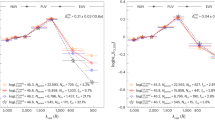Abstract
IT has been noted1–3 that the occurrence of absorption lines in quasi-stellar objects appears to increase with increasing red-shift. This has suggested that QSOs with high red-shift have intrinsically different properties than those with low red-shift. McCrea2, for example, found that 53 per cent of the QSOs with emission red-shift zem > 1.8 have absorption lines; 17 per cent with 1.0 < zem < 1.8 have absorption lines, and only 8 per cent with zem < 1.0. This correlation, however, has been found, using all the observed absorption lines, and it is possible that the correlation is merely the result of stronger lines being brought into the observable spectrum as the red-shift increases. A proper test for such a correlation requires the use of a single line, or else the difference in strengths of lines in different parts of the spectrum should be allowed for.
This is a preview of subscription content, access via your institution
Access options
Subscribe to this journal
Receive 51 print issues and online access
$199.00 per year
only $3.90 per issue
Buy this article
- Purchase on Springer Link
- Instant access to full article PDF
Prices may be subject to local taxes which are calculated during checkout
Similar content being viewed by others
References
Burbidge, G. R., and Burbidge, E. M., Quasi-Stellar Objects (Freeman, San Francisco and London, 1967).
McCrea, W. H., Nature, 218, 257 (1968).
Burbidge, E. M., Tucson Conference on Seyfert Galaxies and Related Objects, Astronomical Journal (in the press).
Braccesi, A., Lynds, C. R., and Sandage, A., Ap. J., 152, L105 (1968).
Lynds, C. R., and Wills, D., Ap. J. (July 1968).
Schmidt, M., and Olsen, E. T., Amer. Astron. Soc. Meeting (April, 1968).
Burbidge, E. M., Lynds, C. R., and Stockton, A. N., Ap. J., 152, 1077 (1968).
Author information
Authors and Affiliations
Rights and permissions
About this article
Cite this article
WEYMANN, R., WILCOX, R. Is the Probability of Occurrence of Absorption Lines in QSOs a Function of Red-shift?. Nature 219, 1031–1032 (1968). https://doi.org/10.1038/2191031a0
Received:
Issue Date:
DOI: https://doi.org/10.1038/2191031a0
This article is cited by
Comments
By submitting a comment you agree to abide by our Terms and Community Guidelines. If you find something abusive or that does not comply with our terms or guidelines please flag it as inappropriate.



